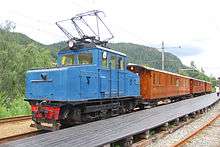Private railways of Norway

Private railways in Norway consist of industrial and public railways. Industrial railways were used to transport ore or other industrial products to ports, although they have, particularly to begin with, also operated passenger and cargo services. The other nine private railways have been public and operated as mixed passenger and freight services.[1] Of these, four were later taken over by the Norwegian State Railways (NSB). Only five non-industrial railways were never nationalized, although all have been closed. There were the Nesttun–Os, Holmestrand–Vittingfoss, Lillesand–Flaksvand, Tønsberg–Eidsfoss and the Lier lines.[2] No industrial railways remain in operation, although one former private railway, the Trunk Line, Norway's first railway, is still in use.[2]
The division between private and publicly owned railways is related to operation rather than ownership. All non-industrial private railways received state grants for construction, while many of NSB's railways were at first organized as limited companies with private owners, although NSB was responsible for all operations and maintenance of the line and rolling stock. For both NSB-run and private, non-industrial railways, municipalities and counties were often the largest owners. Eventually, all the private, non-industrial railways started losing money, and unless they received subsidies, were forced to close. However, the state and municipalities often provided subsidies to keep them operational. The last private railway to close was the Lillesand–Flaksvand Line, in 1958.[2]
List
The following is a list of the private railways in Norway. It includes the line, type (industrial or public), the owner at the time the railway was closed, the longest length of the line, the gauge, the date the line opened, was nationalized and was closed for passenger and cargo, if applicable. The list only contains industrial railways which at some point had regular passenger transport.[3]
| Line | Type | Owner | Length (km) | Length (mi) | Gauge | Opened | Nationalized | Closed (passengers) | Closed (cargo) |
|---|---|---|---|---|---|---|---|---|---|
| Dunderland | Industrial | Dunderland Iron Ore Company | 22.0 | 13.7 | 1,435 mm (4 ft 8 1⁄2 in) | 1 November 1904 | — | — | — |
| Grimstad | Public | — | 22.1 | 13.7 | 1,067 mm (3 ft 6 in) | 15 September 1907 | 24 January 1912 | 1 September 1961 | 1 September 1961 |
| Holmestrand–Vittingfoss | Public | Vestfold Privatbaner | 24.4 | 15.2 | 1,067 mm (3 ft 6 in) | 2 October 1902 | — | 27 September 1931 | 1 June 1938 |
| Lier | Public | — | 20.6 | 12.8 | 1,067 mm (3 ft 6 in) | 2 October 1904 | — | 23 October 1932 | 1 January 1937 |
| Lillesand–Flaksvand | Public | — | 16.6 | 10.3 | 1,067 mm (3 ft 6 in) | 4 June 1894 | — | 15 June 1953 | 15 June 1953 |
| Nesttun–Os | Public | — | 26.3 | 16.3 | 750 mm (2 ft 5 1⁄2 in) | 1 July 1894 | — | 2 September 1935 | 2 September 1935 |
| Rjukan | Industrial | Norsk Transport | 46.0 | 28.6 | 1,435 mm (4 ft 8 1⁄2 in) | 9 August 1909 | — | 1 July 1991 | |
| Solbergfoss | Industrial | Oslo Lysverker | 7.9 | 4.9 | 1,435 mm (4 ft 8 1⁄2 in) | 1918 | — | 4 January 1965 | |
| Sulitjelma | Industrial | Elkem | 38.5 | 23.9 | 1,067 mm (3 ft 6 in) | 13 October 1892 | — | 15 June 1915 | |
| Thamshavn | Industrial | Salvesen & Thams | 25.3 | 15.7 | 1,000 mm (3 ft 3 3⁄8 in) | 15 July 1908 | — | 30 May 1974 | |
| Tønsberg–Eidsfoss | Public | Vestfold Privatbaner | 48.0 | 29.8 | 1,067 mm (3 ft 6 in) | 21 October 1901 | — | 1 June 1938 | 1 June 1938 |
| Trunk | Public | — | 67.8 | 42.1 | 1,435 mm (4 ft 8 1⁄2 in) | 1 September 1854 | 4 March 1926 | — | — |
| Urskog–Høland | Public | — | 56.8 | 35.3 | 750 mm (2 ft 5 1⁄2 in) | 14 November 1896 | 1 July 1945 | 1 July 1960 | 1 July 1960 |
| Valdres | Public | — | 108.6 | 67.5 | 1,435 mm (4 ft 8 1⁄2 in) | 1 September 1902 | 1 January 1937 | 1 January 1989 | — |
References
Bibliography
- Aspenberg, Nils Carl (1994). Glemte spor: boken om sidebanenes tragiske liv (in Norwegian). Oslo: Baneforlaget. ISBN 82-91448-00-0.